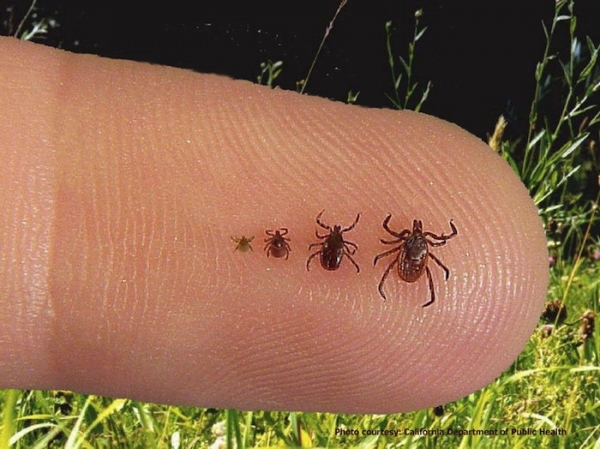NEWPORT — Ticks are a lot like weeds. They survive winter’s freezing temperatures, heavy snowfall and lack of sunshine. These resilient critters can carry pathogens – microorganisms such as bacteria, viruses and parasites, that cause illness.
“Ticks are abundant in all parts of the state. Using bug spray and doing daily tick checks should be part of every Vermonter’s routine,” said Erica Berl, an infectious disease epidemiologist for the Vermont Department of Health. “The earlier you remove a tick, the less likely you are to become sick.”
Thirteen different tick species have been identified in Vermont, but only four are known to carry pathogens that cause disease in humans.
Lyme disease, one of the more common tickborne diseases in Vermont, is transmitted from the bite of infected deer ticks. Symptoms of Lyme disease include an expanding red skin rash, swollen joints and flu-like symptoms. The number of cases reported to the Health Department peaked in 2013 with nearly 900 cases, and there were nearly 600 cases last year.
Transmission can be prevented if the tick is removed within about 36 hours, but the nymphs are so small that they can go unnoticed if you aren’t looking for them carefully. Most infections occur in the summer months when the nymphs are most active.
Lyme disease can be successfully treated with antibiotics, especially if treatment is given early. Left untreated, Lyme disease may affect other parts of the body, including the heart and nervous system. If you believe you may have been infected or have developed a rash or fever, call your health care provider as soon as possible.
The Health Department is advising everyone to take the following actions this spring and summer:
AVOID — Areas that are good tick habitat such as tall grass, or areas with a lot of brush and leaf litter, and along forest edges.
REPEL — Before you go outside, remember to use insect repellant with up to 30% DEET and treat clothes with permethrin. When possible, wear long-sleeved shirts and long pants and tuck your pants into your socks to keep ticks away from your skin. Inspect yourself regularly when outside to catch any ticks before they bite.
INSPECT — Do daily tick checks on yourself, children and pets. Check yourself from head to toe. While nymphs are most commonly found on the lower legs, they may be anywhere on the body.
REMOVE — Remove ticks promptly. Showering within two hours of coming indoors has also been proven effective in preventing Lyme disease by washing ticks off the skin.
For the past two years, the Health Department has encouraged Vermonters to report ticks, including how many, and what type. A deer tick pulled off clothing on Sleepy Hollow Road, in Colchester, and a Lonestar tick pulled off a dog on Mosquitoville Road between Rygate and Peacham were among the hundreds of reports posted on the Health Department’s Tick Tracker website last year.
To report a tick, visit the tick tracker at: https://apps.health.vermont.gov/gis/vttracking/ticktracker/2015/


